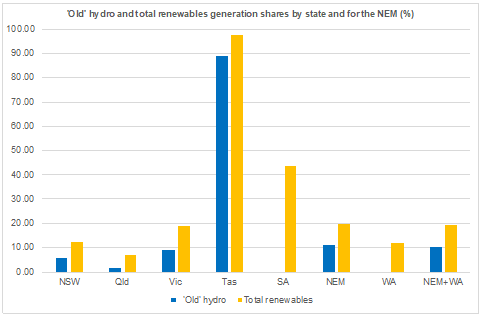Arithmetic is ideology-free. Ignoring its consequences isn't.
Ben Potter wrote a piece on page 6 of The Australian Financial Review for 6 July 2018 titled Renewables generate 19pc of grid already. He cited a report by 'energy expert' Hugh Saddler. The main messages are, (i) in 2017-18 renewable energy generated nearly 19% of national grid power, and (ii) renewables are on track to meet the Turnbull government's emissions target without the national energy 'guarantee'. Saddler says a higher renewables target is 'absolutely' needed. He says it's the lowest-cost way to reduce emissions nationally, because other sectors don't have electricity's 'easy options'. Really?
The claimed 19% share of 'renewables' generation in the NEM looks plausible. Break that down into two components: (i) 'old' hydro, and (ii) 'new' renewables. 'Old' hydro, like 'old' coal, has been around for ages, concentrated in Tasmania, plus some Snowy 1.0. Snowy 2.0 is still an engineer's expensive wet dream. 'New' renewables comprise mainly wind, solar (large-scale and small), and batteries. Here's two charts.
Advertisement


These roughly average current intermittent renewables. The first chart tells us a few things about 'old' hydro:
- By state power generation share, it's concentrated in Tasmania, with small shares in NSW, Victoria, and an even smaller share in Queensland.
- For the NEM, and nationally, it's over half the generation share of all renewables, old and new.
Labelling hydro as a renewable energy source is misleading. To the extent it's 'pumped hydro', and cheap off-peak base-load coal generators pump the water back uphill at night, it's actually coal power.
The second chart above illustrates some key features of 'new' renewables:
Advertisement
- South Australia is the wind power generator leader by a long way. To actually deliver reliable power, (as also shown in the first chart), it's still well short of Jay Weatherill's aspirational 75% RET. Victoria and Tasmania come a distant second, with WA and NSW bringing up the rear.
- For solar, WA has the largest share, Qld is next, then NSW and SA. Vic and Tasmania are also-rans.
- NEM-wide, and nationally, wind power is the largest 'new' renewable with over 8% of total power generation. Solar is next. Batteries are very small to date.
There are two horizontal lines in the second chart. These tell us about power costs (and reliability?):
- The green line shows the share of wind power above which multiplied generation and the need for multiplied battery storage is required for reliable power. SA, alone, is way above this threshold.
- The red line shows the share of solar power above which multiplied generation and the need for multiplied battery storage is required for reliable power. No state is above this - yet.
Discuss in our Forums
See what other readers are saying about this article!
Click here to read & post comments.
51 posts so far.